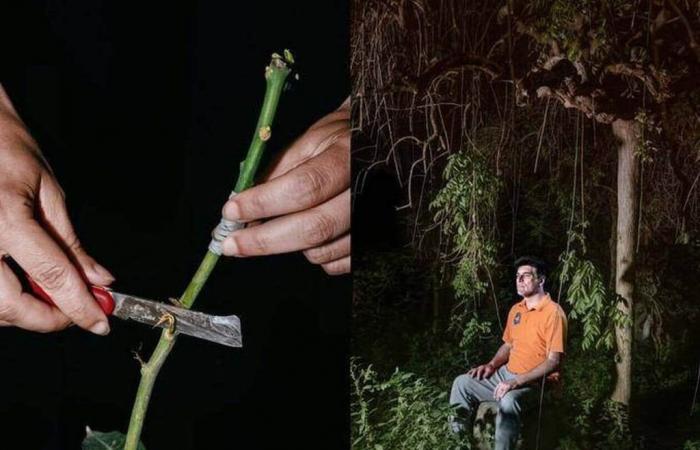
By the evening edition.
Like every year, the Earth Photo competition organized by the British Royal Geographical Society rewards the most striking photos of the evolution of the planet. Between adaptation and transformation in the face of climate change, the eleven photos and videos selected by the jury this edition show the extent to which nature is as beautiful as it is fragile.
On one side, a hand cuts a mango graft with a penknife. On the other, a man sitting on a rock in the middle of the forest. Looking into the distance. A dark diptych where only humans and the green of nature stand out. This photo was captured in Sicily by the Italian photography duo, Jean-Marc Caimi and Valentina Piccinni for their project “Tropicalia”.
Climate change in photos
This series of photos has just been awarded the Earth Photo jury prize. Co-founded in 2018 by the public agency Forestry England, the Royal Geographical Society and Parker Harris, the competition annually rewards images reflecting nature in the face of climate challenges. “This year’s winning images, by photographers and filmmakers, allow us to see with new eyes, through their lens, the beauty, fragility, crises and changes occurring in our natural environment”, comments Mike Seddon, chief executive of Forestry England. Of the 1,900 applications received, the jury selected 11 photographic and also cinematographic projects “exceptional”.
Read also: Global warming may have started earlier than we thought
The winners Jean-Marc Caimi and Valentina Piccinni chose to focus on Sicily, where the drastic effects of climate change impact food sovereignty. “How the world will adapt to the new scenario of our planet is already visible in the struggles of microcosms like Sicily, which has become the epicenter of the new tropical battle”explain the two artists.
Exotic fruits in Sicily
On the three-pointed island, farmers are abandoning citrus cultivation to switch to tropical crops. In the first photo, Francesco Verri. The entrepreneur heads a network of small producers in Messina, who grow lesser-known tropical fruits. Its goal is to establish a “Made in Sicily” brand for exotic fruits, in order to raise awareness among ordinary consumers.
Another photo, another story. That of Elena Giorgianni, naturopath and farmer in the hills of Messina. Here, with climate change, Sicilian farmers are abandoning their land in favor of solar energy systems. She is resisting this trend by growing exotic fruits organically. Faced with rising temperatures, changing precipitation patterns and increased risk of extreme events, this approach balances environmental sustainability and consumer preferences.
Coral protection in the United States
Other projects were rewarded, such as Jennifer Adler’s “Corals of the Future” which received the Climate of Change prize. “During the summer of 2023, an extreme marine heatwave caused massive coral bleaching in the Florida Keys, a reef area that had already declined by 90% due to disease and previous heatwaves”explains the photographer.
Read also: In search of corals resistant to global warming in French Polynesia
In her work, she chronicles both resilience and innovative adaptations for the environment, including that of the Coral Reef Restoration Foundation. Here one of its members, Roxane Boonstra, examines an elkhorn coral tree at the Tavernier nursery, the largest underwater coral reserve in the world.
Guardians of the Colombian forest
The Forest Ecosystem Award went to Marc Lathuillière for “Ser Guardianes Madre Arbol” (Becoming Guardians of the Mother Tree). In northern Colombia, between the Pacific and Atlantic Oceans, the Bajo Atratobasin is a biodiversity zone, one of the wettest and most diverse regions on the planet.
The protection of its tropical forest is intrinsically linked to the survival of hundreds of Afro-descendant communities practicing small-scale sustainable agriculture.
Read also: Protected for 2,500 years by the Amazon forest, this “lost city” is threatened with disappearance
In 2022 and 2023, the La Madre Unión forest faced new threats and illegal clearing. Community leaders invited the videographer to participate in the conceptualization and exhibition of their environmental group, Guardianes Madre Árbol (Guardians of the Mother Tree).
A 14-year-old winner
The David Wolf Kaye Future Potential Prize recognizes a photographer and filmmaker aged 25 or younger. On the photo side, it was Raymond Zhang, a fourteen-year-old student from Shanghai (China), who received the prize.
His photograph “Walking on the Palette” shows a farmer walking along terraces found in southern China, capturing the depths of the color palettes in the landscape. “I take photos of landscapes and people during my travels with my parents. I hope you like the stories behind the photos »declared the young artist.
Between natural and human border
The Earth Photo 2024 Moving Image Prize is awarded to Zula Rabikowska for her short film “The Border Line”. In her film, she transcribes the relationship between land as a natural phenomenon and the political significance of borders. She explores how nature and landscapes are political symbols, carrying human conflicts. To imagine this, she tells the story of her grandfather, who was a child when Poland was occupied by Nazi Germany and the Soviet Union in 1939.
By telling his personal story, the artist highlights the war-torn landscapes, fluctuating borders and conflicting identities of Eastern Europe. “My goal is to contribute to a discussion about nature, boundaries and human nature”explains Zula Rabikowska.
Of course, this is just a sample of the selected and awarded works. They will all be on view in the Earth Photo 2024 exhibition at the Royal Geographical Society, London, until August 21, 2024.





